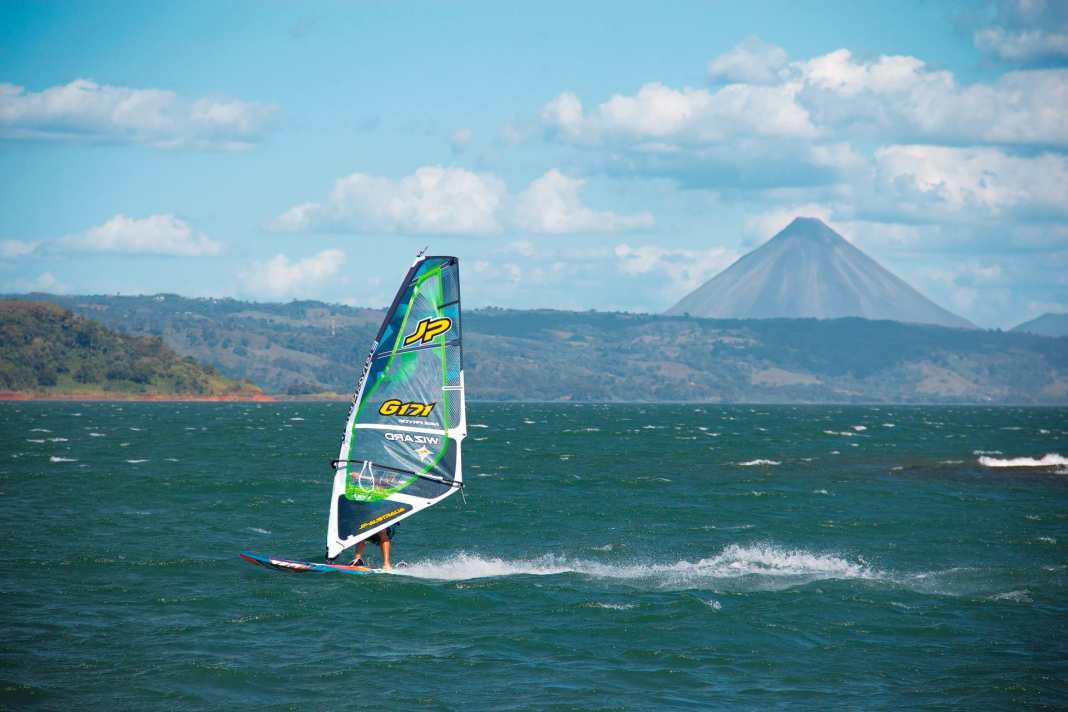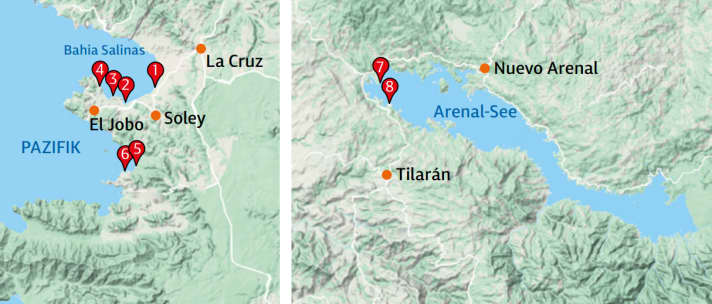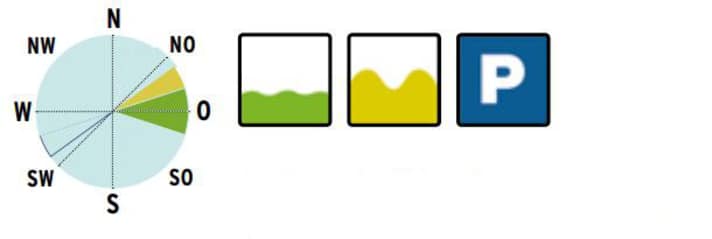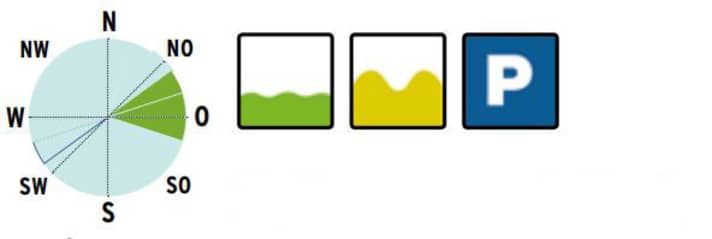





What does "Pura Vida" actually mean? Everyone in Costa Rica talks about it, everyone uses the term many times in the course of small talk - as a greeting, as a farewell - but when asked, somehow no one can explain exactly what Pura Vida actually means.
Bluntly translated, the term means something like "pure, simple life", but anyone who gets off the plane in San José to see Costa Rica for themselves quickly realises that there is much more to it than just a phrase: a philosophy, an attitude to life. Scientists are still arguing about the exact origin of the term. It is assumed that a Mexican film called "Pura Vida", which was broadcast in Costa Rica in 1956, got the ball rolling at the time. In this film, things don't really go well for the main character, but he tries to continue to see the positive by using the phrase "Pura Vida".
Ultimately, this is exactly what characterises the term today and what has developed into the philosophy of life of the "Ticos" since the 1970s: Not to pay too much attention to the negative, to be happy about the little things in life. To be relaxed, find happiness and enjoy the good things in life. And to preserve them.
Costa Rica is rich in natural wonders and very progressive
The Ticos are very proud of the beauty of their country and rightly so. Framed by the Caribbean Sea and the Pacific Ocean, a country unfolds over almost 300 by 150 kilometres that is as rich and varied in natural wonders as any other continent: mystical cloud forests, wild rivers, endless palm beaches, barren plateaus and steaming volcanic cones that scratch the 4000 metre mark are relatively close to each other here.
And because the Pura Vida attitude to life did not stop at politics, many things developed more positively in Costa Rica than in other Central American countries: the military had already been abolished shortly after the end of the Second World War in order to set up social and educational programmes with the freed-up budget. But much has also been achieved on an ecological level. While almost 80 per cent of Costa Rica's rainforests were once deforested, environmental protection became a government task in the early 1970s. The first national park had already been established in 1969 and, at the latest since the then President Oscar Arias presented his "Peace with Nature Initiative" in 2007, the path to an ecological tack has been consistently pursued.
Today, more than 50 per cent of the country is once again covered by forests, almost 30 per cent of the land area is protected and there are more than 150 national parks, protected areas and reserves throughout the country. Costa Rica already covers the majority of its energy needs from renewable sources, and the Ticos want to be climate-neutral by 2050 - the first country in the world to do so. Pura Vida!
The fact that climate neutrality could actually work is due to two energy sources that Costa Rica has been particularly blessed with. Water and wind - and at this point at the latest, windsurfers are also pricking up their ears.
Papagayo power
With its location between the eighth and eleventh degree of latitude, Costa Rica lies in the catchment area of the north-east trade winds. However, while this usually only gently fans ashore on the Caribbean coast, topographical features such as mountains and valleys with a funnel effect ensure that two regions in the north of Costa Rica are among the windiest corners of the world in winter. The Ticos also call the strong east wind "Papagayo". The first windsurfing region is located in the far north, almost on the border with Nicaragua. The landscape here is almost barren and it gets very hot, so more than a shorty is not necessary at the spots of the large Bahia Salinas. If you're used to the hustle and bustle of European spots, you might find it a little too lonely on the water here - with the exception of a few kiters and the occasional windsurfer, you'll have the cream spots largely to yourself.
The most famous spot in Costa Rica is the Arenal Reservoir
Those longing for a little more company will find it at what is probably Costa Rica's most famous spot - the Arenal. The artificial reservoir, located around 150 kilometres northwest of the capital San José, lies at the foot of the picture-book volcano of the same name, Arenal, which is still active. Between November and April, it blows here with more than four Beaufort winds on almost 90 per cent of the days. Thanks to a 20-kilometre run-up, steep waves build up on strong wind days - and there are plenty of them here - that sometimes make you forget that you are surfing on a lake. A small surfing scene has also developed here and there is a windsurfing centre on site, so you can travel to Costa Rica without your own equipment.
This also has the advantage that you can combine extensive sightseeing trips and windsurfing fun without having to hire your own car. Traffic in the cities and the quality of some of the roads are among the few things in Costa Rica that do not always seem life-affirming. If you don't have your own car, travelling by public transport is no problem - ideally by bus. By Central American standards, buses run fairly reliably between all the relevant places, are generally comfortable and air-conditioned, but usually also stop at every milk can - and sometimes even full at the garage for a spontaneous tyre change. It's best to do as the Ticos do: stay relaxed and make the most of every day. Pura Vida!
Windsurfing spots in Costa Rica

1st Puerto Soley

Coming from La Cruz, you reach the Puerto Soley spot in a westerly direction and can park directly in front of the houses on the beach. Normally, the Papagayo blows here at full strength after breakfast, and the wind often weakens noticeably from 14:00. The tide doesn't have much influence on the spot conditions here, the wind blows diagonally offshore out to sea - so knowing how to waterstart is a must here. It is still noticeably gusty, especially in the shore area, and the lines and buoys of the small fishing boats can also be small tripping hazards. A little further out, however, you have a clear path, the wind stabilises noticeably and you can enjoy beautiful speed runs that are only disturbed by small wind waves. There are a few restaurants and bars in the village, and the small town of La Cruz is also not far away - here you can enjoy your evening meal in some restaurants with a great view over the Bahia Salinas.
2nd Playa Papaturo

Playa Papaturo is also reached by travelling west from La Cruz on the main road 935, turning right after the Blue Dream Hotel and following the gravel road down to the beach, where you can park under the trees. As in Puerto Soley, the wind here is often strongest in the morning and weaker in the late afternoon. The wind here comes sideshore from the right, near the beach the water is still nice and flat, further out the chop builds up, which is probably aptly described by the term "bump & jump" and is quite steep enough to really spiral up into the air. Playa Papaturo is safer than Soley due to the sideshore wind. The only dangerous thing here - no joke - are the sea turtles, which with their stoic calm sometimes appear directly in front of the bow and have caused many a catapult. After the session, you can replenish the calories you've surfed away in the restaurant of the nearby Blue Dreams Hotel - for example in the form of a delicious ceviche.
3rd Playa Copal

The turn-off from road 935 down to the Playa Copal spot is at the restaurant "El Fogon de Juana" - where, by the way, you can get good home cooking. Here, too, the last few metres to the water are on a dirt road and it is best to follow the signs to the beach and Kiteboarding Costa Rica. There are car parks at the spot and you can rig up in the shade of some trees. In general, Playa Copal is rideable at any tide, but at medium to low tide you can enjoy a special treat: a natural breakwater forms upwind of the entrance in the form of a dry reef, behind which no micro-chop will interfere with your next speed run or freestyle trick. Of course, word has got around in the kite scene that you are never alone on the water here. At the beginning, you should approach the shallows carefully to avoid sinking your fin, as there are no replacements to be had here. Further out in the Bahia Salinas, the water is deep enough everywhere and you have enough space to cruise around the bay to your heart's content. If you want to stay longer, you can book accommodation in various price categories, from budget hostels to exclusive private villas, through Kiteboard Costa Rica, for example.
4th Playa La Coyotera Rajada

If you head towards the western end of Bahia Salinas, towards Playa La Coyotera, the wind comes increasingly onshore. The small stretch of beach to the north of the main Playa Rajada beach can be found by following the signs to Hotel Bolanos. Directly behind the hotel, turn right onto a gravel road where you can park close to the beach. Because the wind comes onshore to the shore, you can surf very safely, drifting off is hardly possible. A small, steep swell builds up when the Papagayo is strong and constantly arriving here, which runs in the direction of the wind but is still suitable for small jumps. Isla Bolaños lies just under a kilometre off the coast, and its wind cover can be noticeable depending on the wind direction. Accordingly, the area with constant wind is sometimes somewhat smaller.
5th Playa Junquillal

This beautifully located spot can be reached from La Cruz in a southerly direction. In the village of Soley, follow the signs in the direction of "Playa Junquillal". As the spot is located in a nature reserve, the "Junquillal Wildlife Refuge", you have to pay an entrance fee. Junquillal is primarily a recommendation when the Papagayo is very strong, as the wind then comes through quite well here. From the shore, you first have to leave the wind cover in the shore area to feel the full force of the wind. As the typical easterly wind blows offshore here and there is no safety back-up such as lifeboats or lifeguards, Junquillal is not a good spot for intermediates, but rather for experienced surfers who can safely launch and cross the water and live with the often somewhat gusty wind. If you want to cruise up, it is best to land at the southern end of the bay and then easily pull your equipment back to the entry point in the shore area. The water is slightly colder than in Bahia Salinas due to the full offshore wind, but you are sufficiently equipped with a shorty. On the other hand, you can enjoy great flat water here, which is perfect for practising manoeuvres and freestyling. You can stay overnight at the local campsite and the local restaurant Marisqueria Boulevard is an absolute recommendation!
6th Playa Bassey

If you are bothered by the offshore wind in Junquillal, you can also start a few minutes further west at Playa Bassey. Head south past Junquillal and shortly afterwards turn right onto a steep gravel track towards the water. Here the wind comes almost sideshore from the right, but the entrance is rocky and further downwind there is no emergency exit. You will then be surfing on the same playground as at the entrance in Junquillal.
7th Arenal / Tico Wind

Lake Arenal, which is around 30 kilometres long and up to 60 metres deep, is picturesquely situated at the foot of the volcano of the same name and is worth a visit for its scenery alone. At the western end of the lake, turn off the main road 142 and follow the signs for "Tico Wind" along a dirt road to the water. While the spots in Bahia Salinas are often lonely, there is always a small surfing community here. The Tico Wind surf centre offers the necessary infrastructure, including a meadow for rigging, rental equipment, SUP boards, storage facilities for your own equipment, a small surf shop and catering. The wind blows across the entire Arenal Lake and comes in quite evenly and diagonally onshore from the left, often at over 30 knots. Due to the depth of the water, a steep wind wave then forms for jumping around; on stormy days, this becomes over head-high and is even used by the cracks for back- and push-loops. Apart from the storm days when shorebreak occurs, it is still quite easy to get in. The temperatures here are slightly cooler than on the Pacific coast, but a shorty will always suffice. The only tip: don't leave wet neos lying around, the occasional scorpions also like it damp and cool.
8th Arenal / Old Tilawa

If you have your own equipment, you can also hit the water a few kilometres south of Tico Wind, at the spot of the now closed Old Tilawa windsurfing centre. There is plenty of space for parking and rigging, as well as space on the water. The Papagayo whistles just as strongly here as at the spot at Tico Wind, but comes from the right and also offers steep chops for plenty of airtime. Theoretically, you can practise jumps from the right here and reach Tico Wind in one go to perfect jumps to the left. Apart from a few stones in the entry area, Old Tilawa is a very uncomplicated spot, albeit without any major infrastructure. This is available again in Tronadora, just under nine kilometres away.
Area information Costa Rica
Journey
Flights to San José, the capital of Costa Rica, are usually available with a stopover in the USA and cost between 600 and 1000 euros, depending on the season. You should definitely check the baggage conditions if you want to travel with your own equipment, as you will often be travelling with different airlines on the various legs of the journey, which have different baggage regulations and prices. It is advisable to book flights through a travel agency and have special baggage confirmed. Onward travel on site can be done by hire car, which costs around 40 to 50 euros per day. It is often not possible to get a hire car directly at the airport, so it is best to take a taxi to the pick-up address and then pick up fellow travellers from the airport. The windsurfing spots in this guide can be reached from San José in four to five hours via Route 1 northwards.
Living
Costa Rica is well developed for tourism and you can easily find B&Bs, flats or hotels in all price categories via the well-known online booking platforms. If you are not necessarily travelling during the holiday season between December and February, you can easily do without pre-booking and will certainly find what you are looking for quickly on site - sometimes it is even cheaper than pre-booking online.
Wind, weather & neoprene recommendations
The underlying wind system is the same one that ventilates the rest of the Caribbean region so constantly in winter - the trade wind. It results from a pressure gradient between an area of high pressure in the subtropical latitudes and a heat low over the equator. Deflected by the Earth's rotation, it usually arrives in Costa Rica as an easterly wind. Local effects sometimes amplify the trade wind massively; the Ticos also call the wind "Papagayo". The best time to go windsurfing is during the dry season between December and April, when the wind blows most reliably. Lake Arenal, for example, is one of the windiest places in the world in winter, with winds blowing with gliding force around 90 per cent of the time. The wind usually starts in the morning and often increases to over 25 knots during the course of the day. With average temperatures of around 30 degrees (in the mountains it often stays a little cooler, on the coast it gets hotter), people usually surf in shorts. At the Pacific spots around the Bahia Salinas, the offshore Papagayo pushes the warm water away from the coast, causing colder deep water to flow upwards - a shorty is therefore advisable. Always make sure you wear sufficient sun protection.
Surf stations & shops
Costa Rica is only sparsely developed with surfing infrastructure, but if you limit your choice of spots to Lake Arenal, you can leave your own equipment at home. At Tico Wind (www.ticowind.com) you can hire the latest windsurfing equipment and SUP boards, and this is also the only place where you can get replacements for broken equipment.
Alternative programme
Costa Rica is an extremely diverse country that is just too good for windsurfing. Barren plateaus with active volcanoes alternate with tropical rainforests, wild river landscapes and beautiful sandy beaches - all in a relatively small area. Whether rafting on the Balsa River, hiking through the Monteverde Cloud Forest or one of the numerous other national parks, or surfing on the dream beaches of the Pacific - the journey should be the destination. Tip: Instead of rushing straight north from the airport in San José, you can first relax for two days in beautiful nature around the Poas volcano, not far from the capital!
Good to know
Costa Rica is a very safe country to travel in, although you should be careful in the big city of San José and keep an eye on your luggage on public buses. The roads are often in poor condition and winding, which means that even supposedly short journeys can drag on - so take things easy. The risk of malaria is very low, but mosquitoes are a constant companion - a mosquito net and mosquito spray are a must.
This spot guide first appeared in surf 1-2/2020

